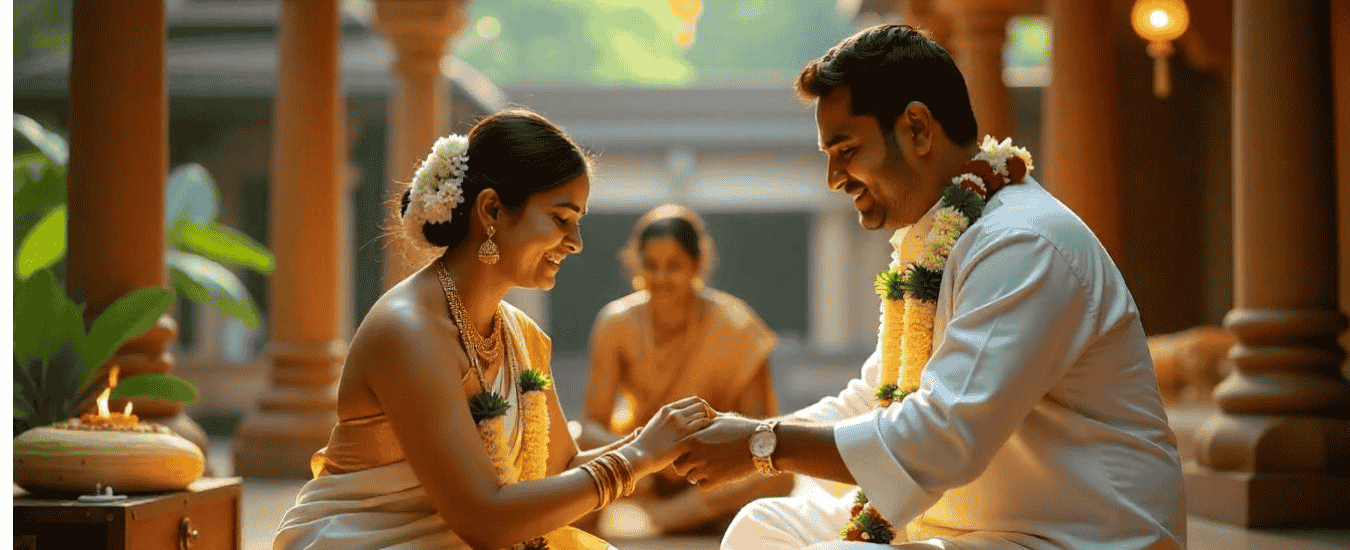A Kerala Hindu wedding isn’t just a ritual—it’s a sacred fusion of spirituality, cultural values, and family bonds. Rooted in Vedic wedding customs, these celebrations are minimalist yet emotionally rich, leaving lasting impressions.
Kerala Hindu weddings are a soulful blend of timeless Vedic traditions, regional beauty, and heartfelt community bonds. Whether traditional or modern, they celebrate the union of souls, families, and cultural legacy with unmatched elegance.
What Makes Kerala Weddings Unique?
Kerala weddings reflect simplicity, sanctity, and soulful elegance. Most traditional weddings here are completed in under an hour, yet they brim with symbolic Vedic rituals and timeless traditions.
Diversity of Hindu Communities in Kerala
Communities like Nairs, Ezhavas, and Brahmins add their distinct flavour to the wedding. Each follows shared Hindu scriptures yet brings regional adaptations in rituals, mantras, and traditions.
Pre-Wedding Rituals in Kerala Hindu Weddings
Jathakam Matching and Muhurat
The wedding journey begins with Jathakam (horoscope) compatibility, guided by the family astrologer. Based on vedic astrology, a muhurta (auspicious time) is chosen for solemnizing the union.
Nishchayam – The Engagement Ceremony
This intimate ceremony formalizes the matrimonial alliance. Families exchange gifts, betel leaves, and traditional clothes, setting wedding plans in motion.
Pre-Marital Poojas and Blessings
To ensure divine blessings, rituals like Ganapathi Homam and Navagraha Shanti are performed at home. Couples may visit local temples or perform a yajna (fire ritual) with Vedic chants.
Wedding Attire and Ritual Symbols
Bridal Elegance – Kasavu Saree & Gold
The bride wears a Kasavu saree adorned with gold jewelry like oddiyanam, bangles, and jhumkas, symbolizing Lakshmi’s blessings. Fresh jasmine flowers complete her divine look.
Groom’s Ensemble – Mundu and Simplicity
The groom wears a mundu with a golden border and a white kurta or shirt—symbolizing purity and tradition. Some may also wear angavastram during rituals.
Sacred Items and Decor
The mandap is decorated with banana trunks, thoranams, and kolam. Sacred items like kuthuvilakku, kalasham, and turmeric paste are essential during rituals.
The Wedding Day Ceremonies
Varavippu – Welcoming the Groom’s Party
The groom’s arrival is greeted with thalam, nadaswaram, and chenda melam—creating a festive, spiritual atmosphere.
Kanyadaanam – Giving Away the Bride
A purohit (priest) guides this Vedic ritual where the bride’s father hands her over to the groom, invoking gotra and lineage prayers.
Thalikettu – Tying the Sacred Thaali
As the groom ties the thaali (mangalsutra), sacred mantras are chanted. This is the pivotal moment of becoming husband and wife.
Saptapadi – Seven Sacred Steps
In Brahmin and other communities, couples take seven steps around the sacred fire (Agni), each step promising lifelong commitment.
Homam – Fire Offerings
The couple performs homam, offering ghee, herbs, and rice to Agni, the divine witness of their union.
Post-Wedding Rituals and Festivities
Grihapravesham
The bride is welcomed into her new home with Arti, and she gently kicks a rice pot—signifying prosperity.
Wedding Feast – Traditional Sadya
The Sadya, served on banana leaves, features over 20 items like avial, olan, thoran, pachadi, and payasam—a vegetarian feast like no other.
Reception and Community Gathering
Post-wedding, a wedding reception is held with music, cultural dance, and social bonding. Modern setups also include wedding stage decor and DJ entertainment.
Community Variations
Nair Weddings
Swift and elegant, Nair weddings are often free from heavy Vedic chants, focusing more on familial unity and symbolism.
Ezhava Traditions
In Ezhava weddings, Ashtamangalyam—eight auspicious items—are placed on the mandap for blessings.
Kerala Brahmin Rituals
These are deeply Vedic, spanning two to three days. They include Upanayanam, Panigrahanam, and complex fire rituals conducted by Sanskrit-versed priests.
Music, Art & Modern Trends
Traditional Music and Dance
Chenda melam, nadaswaram, and folk songs elevate the mood. Some weddings also feature Mohiniyattam and Kathakali performances.
Decor and Kolam
Kolam designs, leaf garlands, and floral mandaps add divine aesthetics. Kuthuvilakku lamps light the sacred space.
Modern Kerala Weddings
Today, couples prefer destination weddings in Alappuzha, Kumarakom, and Wayanad, blending tradition with modernity. Elements like haldi ceremony, mehendi nights, sangeet, and cake cutting are common.
FAQs
What is the significance of the ‘thaali’ in Kerala weddings?
The ‘thaali’ or mangalsutra represents the sacred bond of marriage and is tied by the groom around the bride’s neck as the most important ritual.
Are Kerala Hindu weddings typically short or long events?
Most traditional Kerala weddings are short and sweet, often wrapped up in less than an hour, especially among the Nair and Ezhava communities.
Do Kerala weddings involve dowry traditions?
While dowry was historically practiced, modern Kerala weddings are increasingly moving away from this custom, especially in urban areas.
What food is served at a Kerala wedding?
A grand vegetarian feast called Sadya is served, featuring dishes like avial, thoran, olan, and multiple types of payasam.
Can non-Keralites have a traditional Kerala wedding?
Absolutely! Many people from outside Kerala opt for traditional Kerala-style weddings to embrace its culture and simplicity.
